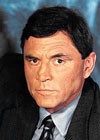|
Week of August 20, 2001 Snapshot from the Field |
|
3,400 Jobs Saved  Mitsubishi Investment Means Australian Auto Plants Won't Close
By JACK LYNE
TOKYO -- A huge sigh of relief has gone up down under: Mitsubishi Motors Corp. (MMC at www.mitsubishi-motors.co.jp) has decided to continue manufacturing in Australia. The decision came after months of rampant speculation that MMC would next year close its two plants in Adelaide (www.adelaide.sa.gov.au), which employ some 3,400 workers.
Instead, Tokyo-based MMC has committed US$37 million to manufacture upgraded and redesigned Magna and Verada models in Adelaide. MMC Chief Operating Officer Rolf Eckrodt described the investment as the first step in the ailing automaker's "global image program," headed by newly hired chief designer Olivier Boulay. Said Prime Minister Howard (pictured after his 1998 election win) of his meeting with MCC, "I outlined the benefits of the company's longer-term commitment to our country, the very strong Australian economy, the very competitive exchange rate and all the other benefits that flow from the government's motor manufacturing policy."
COO Eckrodt (above), the turnaround artist who's shaken up MMC, said, "I hope that now the Australian public can be assured of Mitsubishi's commitment in Australia."
Australian Arm Projects 2001 Profit Eckrodt announced the Adelaide investment after meeting in Tokyo with Australian Prime Minister John Howard (www.pm.gov.au).MCC made the decision, Eckrodt explained, after analyzing its Australian subsidiary's business prospects. Despite the last two years' aggregate loss of $170 million, the Australian operation is reportedly on track to post a $5.1 million profit in 2001. Substantial increases in export sales, particularly to the Middle East and the United States, are fueling the turnaround, MCC officials said. In addition, Mitsubishi Motors Australia had already endured a painful revamping. Last year, the subsidiary axed 1,000 jobs. Reversing the priorities of many layoffs, two-thirds of the eliminated jobs were in management, while one-third were in plant production. "They have already done the necessary restructuring," a Mitsubishi spokesman said. As part of its restructuring, MMC will soon close its plant in Nagoya, Japan, the oldest of its four Japanese vehicle assembly plants. MMC Could Get $103 Million from ACIS "There is no reason on the basis of [this] investment that there shouldn't be continuity of employment until at least 2005," Howard said after arriving in Sydney from Japan. "This very good news for Mitsubishi workers."It was also very good news for his administration. Howard is facing a federal election this year, and his Liberal Party has a precarious hold on several seats in the Adelaide area. Said Howard of his Tokyo meeting with Eckrodt, "I outlined the benefits of the company's longer-term commitment to our country, the very strong Australian economy, the very competitive exchange rate and all the other benefits that flow from the government's motor manufacturing policy." By staying in Adelaide, MMC will be entitled to some $103 million under Australia's Automotive Competitiveness and Investment Scheme (ACIS). ACIS went into effect on Jan. 1, 2001, and runs for five years. The program rewards automakers with transferable import duty credits based on production, investment and R&D activity. The ACIS was cited as a major reason for last year's decision to locate Holden's $400 million, 600-employee V6 plant in Melbourne. The Mitsubishi nail-biter has prompted some Australian leaders to call for changes in the nation's policy on auto import tariffs. Fixed at 15 percent in 2000 to buttress the domestic industry, the auto import tariff is scheduled to fall to 10 percent in 2005. Four companies - Ford, Holden (a General Motors subsidiary), Mitsubishi and Toyota - manufacture autos in Australia. Nissan once did, too, but pulled out in 1992 after years of unprofitability. Eckrodt Shakes Up MMC's Focus Another factor fueling fears of the Australian plants' shutdown was DaimlerChrysler's takeover last year of a controlling interest in MMC. Instead, DaimlerChrysler's aggressiveness in trying to resuscitate MMC may have saved the Australian operation.In early 2001 DaimlerChrysler brought in Eckrodt, known as a corporate turnaround wizard. Eckrodt soon shook up MMC by bringing in Boulay as chief designer. Boulay spearheaded the exterior design of the popular new Mercedes-Benz C-class and S-class. Eckrodt also put MMC's Car Design Division under his direct control. And he merged car development and marketing strategy, putting the product development focus on customer needs and preferences - a shift from MMC's more engineering-centric approach. "I can imagine MMC could recover quicker than planned," Boulay declared shortly after taking his new position. In Adelaide, Boulay's notion would certainly raise a rousing "good onya".
©2001 Conway Data, Inc. All rights reserved. Data is from many sources and is not warranted to be accurate or current.
|
 Eckrodt, however, expressed "disappointment at the many recent media reports that have created much unwanted confusion here in Tokyo and in Australia. I hope that now the Australian public can be assured of Mitsubishi's commitment in Australia."
Eckrodt, however, expressed "disappointment at the many recent media reports that have created much unwanted confusion here in Tokyo and in Australia. I hope that now the Australian public can be assured of Mitsubishi's commitment in Australia."